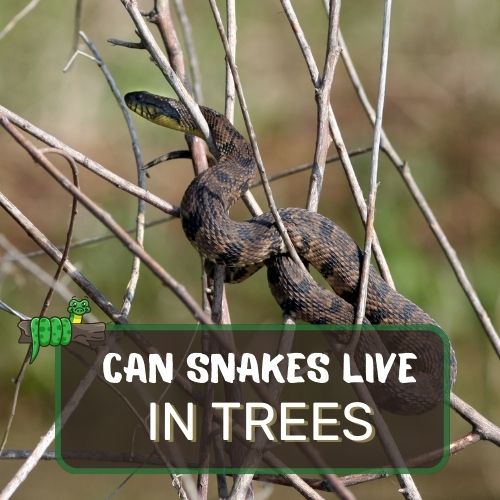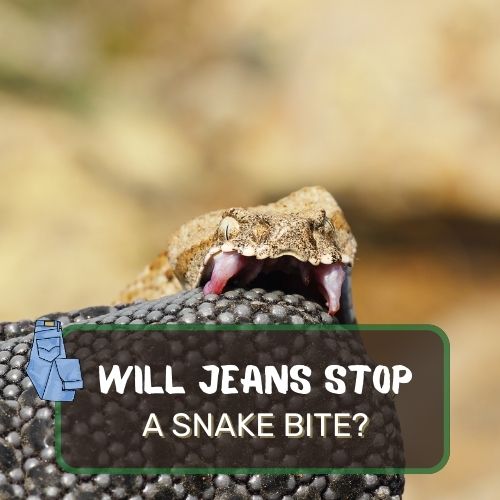
In the captivating world of wildlife, one intriguing question stands out: “Can snakes live in trees?”
This article delves into the fascinating realm of arboreal snakes, exploring their remarkable adaptations, behaviors, and interactions within tree-rich habitats.
Discover the snake species that call the treetops home, uncover the secrets of their climbing prowess, and learn about their hunting techniques and interactions with other tree-dwelling species.
Join us on a journey through diverse ecosystems, from rainforests to temperate forests, as we unravel the wonders of these tree-dwelling serpents.
By the end, you’ll have a deeper appreciation for the coexistence of snakes and trees, and understanding the importance of preserving their unique habitats.
Table of Contents
- 1 Can Snakes Live In Trees? Short Answer
- 2 Snake Species that Live in Trees
- 3 Adaptations of Arboreal Snakes
- 4 The Behavior of Arboreal Snakes
- 5 How Snakes Climb Trees
- 6 Benefits and Challenges of Tree-Dwelling for Snakes
- 7 Examples of Arboreal Snake Habitats
- 8 Interactions with Other Tree-Dwelling Species
- 9 Human-Snake Conflicts in Tree Habitats
- 10 FAQ
- 11 Conclusion
Can Snakes Live In Trees? Short Answer
Yes, snakes can indeed live in trees. Some snake species are specifically adapted to life in the treetops and are known as arboreal snakes. These serpents have evolved unique characteristics and behaviors that allow them to thrive in tree-rich habitats. They are adept climbers, using their specialized scales and prehensile tails to move gracefully through the branches.
Arboreal snakes can be found in various environments, from rainforests and tropical forests to temperate forests and even coastal and island habitats.
Their remarkable adaptations and ability to blend in with the foliage make them well-suited for a life among the treetops.
Snake Species that Live in Trees

Western and Eastern Natal Green Snakes
In the lush forests of Southern Africa, the Western and Eastern Natal Green Snakes thrive in the canopies of trees. These slender and agile serpents have vibrant green scales, perfectly blending with the foliage around them.
Their excellent climbing abilities allow them to move effortlessly through the branches, while their smaller size enables them to access tight spaces.
Green Tree Python
Venturing to the exotic rainforests of Southeast Asia and Northern Australia, we encounter the stunning Green Tree Python. These magnificent creatures are true masters of tree-dwelling.
Their bodies are perfectly adapted for life in the canopy, featuring a prehensile tail that acts like an extra limb, providing stability and agility during their tree-bound excursions.
Their emerald green coloration with striking yellow patterns allows them to become one with the leaves, making them nearly invisible to unsuspecting prey.
Adaptations of Arboreal Snakes

Body Shape and Size
One of the most apparent adaptations of arboreal snakes is their body shape and size. These snakes are typically slender and elongated, allowing them to move swiftly through the branches without getting entangled.
Their streamlined bodies reduce wind resistance, enabling them to glide effortlessly from one tree to another.
Prehensile Tails
Perhaps one of the most remarkable features of arboreal snakes is their prehensile tail. Unlike their terrestrial counterparts, these snakes have evolved a specialized tail that acts like a fifth limb.
This incredible adaptation provides them with an exceptional grip on branches, ensuring they maintain their balance even on the thinnest twigs.
Specialized Scales and Grip
Arboreal snakes possess specialized scales on their bellies that are slightly keeled or ridged. These adaptations enhance their grip on smooth surfaces, such as tree bark.
Additionally, some species have modified ventral scales, which create a larger surface area for gripping, enabling them to maneuver confidently through their lofty domain.
Camouflage and Coloration
To survive in the dense foliage, arboreal snakes have evolved astonishing camouflage and coloration. Their scales often mimic the colors of leaves or tree bark, making them virtually invisible to both predators and prey.
This deceptive tactic allows them to strike unsuspecting prey and avoid becoming a meal themselves.
The Behavior of Arboreal Snakes

Arboreal snakes exhibit fascinating behavior that allows them to thrive in their tree-dwelling habitats. Let’s explore some of their noteworthy behaviors:
Hunting and Feeding Habits
Arboreal snakes are skilled hunters, utilizing their agility and camouflage to ambush unsuspecting prey.
From birds and small mammals to other tree-dwelling creatures, these serpents have adapted their hunting strategies to suit their treetop lifestyle.
Some snakes, like the Green Tree Python, use their prehensile tails to secure themselves on a branch while they strike at passing prey below. Once the prey is caught, they use their sharp teeth to deliver a quick and efficient bite.
Reproduction and Mating
The mating rituals of arboreal snakes are as fascinating as their hunting techniques. While each species has its unique courtship behaviors, many rely on scent and pheromones to attract potential mates.
Some snakes engage in elaborate dances, intertwining their bodies in a mesmerizing display.
Once a successful courtship has taken place, the female may lay her eggs in tree hollows or crevices, providing a safe and elevated environment for the development of her offspring.
Sunbathing and Thermoregulation
Like all reptiles, arboreal snakes are ectothermic, meaning they rely on external sources of heat to regulate their body temperature.
Basking in the sun is an essential part of their daily routine, helping them maintain their metabolic activity and digestion.
By positioning themselves on sunlit branches, they absorb warmth through their scales, allowing them to remain active and alert.
Avoiding Predators
Despite their impressive adaptations, arboreal snakes are not without their own predators. Birds of prey, such as hawks and eagles, pose a significant threat to these serpents while they are perched in the open.
To avoid detection, some species have developed unique behaviors, such as freezing in place when approached or gently swaying with the breeze to mimic foliage movement. Their cryptic coloration also aids in remaining undetected by potential threats.
How Snakes Climb Trees

The ability of arboreal snakes to gracefully navigate through tree canopies is nothing short of awe-inspiring. Let’s delve into the mechanics of their tree-climbing prowess:
Muscle Coordination and Flexibility
Arboreal snakes possess powerful muscles and exceptional flexibility, enabling them to move with ease along branches and through complex tree structures.
Their vertebrae have additional joints, which facilitate the contortions needed to traverse intricate paths.
Belly Scales and Grip
The scales on the belly of arboreal snakes play a crucial role in their climbing ability. These scales have specialized structures, such as keels or ridges, that provide improved grip on tree surfaces.
As the snake moves, its belly scales press against the rough texture of the bark, preventing it from slipping or falling.
Techniques for Ascending and Descending
When climbing upwards, arboreal snakes use a combination of muscular propulsion and gripping with their belly scales to make steady progress.
They also use their prehensile tail as an anchor, wrapping it around branches for additional support. While descending, these snakes rely on controlled and deliberate movements to ensure their safety.
Arboreal snakes have truly mastered the art of living in trees.
Their behaviors, climbing abilities, and remarkable adaptations continue to captivate researchers and nature enthusiasts, providing a fascinating glimpse into the extraordinary world of these tree-dwelling serpents.
Benefits and Challenges of Tree-Dwelling for Snakes

Living in trees offers arboreal snakes a range of advantages and hurdles. Let’s explore some of the benefits and challenges they face in their treetop habitats:
Abundant Food Sources
One of the primary benefits of arboreal life is the abundance of food sources available in tree-rich environments.
Tree-dwelling snakes have access to a diverse range of prey, including birds, small mammals, lizards, and insects, which makes it easier for them to find sustenance.
Protection from Predators
Trees provide a natural refuge for arboreal snakes, offering protection from ground-dwelling predators.
The height and complexity of the canopy make it challenging for terrestrial predators to reach them, reducing the risk of becoming prey.
Exposure to Environmental Hazards
Living high above the ground comes with its share of environmental hazards. Storms, strong winds, and extreme temperatures can pose risks to arboreal snakes, making their treetop existence a delicate balancing act between safety and exposure.
Competition for Tree Resources
The limited space and resources in trees can lead to intense competition among arboreal snakes and other tree-dwelling creatures. Securing a prime spot for basking, resting, or nesting can be highly contested in densely populated tree communities.
Examples of Arboreal Snake Habitats

Rainforests and Tropical Forests
Rainforests and tropical forests are home to some of the most diverse and stunning arboreal snake species. The lush canopies of these environments provide a rich and varied ecosystem for these serpents to thrive.
Green Tree Pythons, vine snakes, and various tree vipers are among the remarkable species that have adapted to the challenges and rewards of life in these dense and vibrant habitats.
Savannas and Grasslands
While not as tree-dominant as rainforests, savannas and grasslands still offer opportunities for snakes to live among the trees. Certain regions feature isolated tree patches or gallery forests along riverbanks, providing vital refuge for tree-dwelling snakes.
Here, snakes like the Western and Eastern Natal Green Snakes may find a suitable habitat where trees intersect with open grasslands.
Temperate Forests
Arboreal snakes can also be found in temperate forests, adapting to seasonal changes and cooler climates.
These habitats may be home to species like the Eastern Rat Snake or European adders, which have evolved to navigate the tree canopies in these regions.
Coastal and Island Habitats
Coastal areas and islands often support unique arboreal snake communities. Coastal forests and mangrove ecosystems provide important habitats for snakes like the mangrove snakes and some tree-dwelling sea snakes.
Island habitats, with their isolation and unique ecosystems, have also given rise to fascinating and distinct arboreal snake species.
As we explore these diverse case studies, we gain a deeper understanding of how arboreal snakes have found their place in various habitats worldwide.
Each environment presents its own set of challenges and rewards, leading to the evolution of an array of arboreal species, each uniquely equipped to thrive in their treetop domain.
Interactions with Other Tree-Dwelling Species

Life in the treetops brings arboreal snakes into contact with various other tree-dwelling species. Let’s explore some of the fascinating interactions they have:
Birds and Their Nests
Birds and arboreal snakes often share the same domain in trees, leading to interesting interactions.
Some snake species, like the rat snake, may take advantage of abandoned bird nests as suitable spots for shelter or laying their eggs.
However, this can sometimes lead to conflicts with returning bird parents who may perceive the snake as a threat to their offspring.
Squirrels and Other Small Mammals
Arboreal snakes may encounter squirrels and other small mammals in the treetops. These interactions are typically focused on hunting, as both snakes and small mammals compete for the same food sources.
Certain snake species have adapted to prey on small mammals, and their hunting prowess plays a crucial role in maintaining the ecological balance in these habitats.
Insects and Arachnids
The tree canopies are bustling with insect and arachnid activity, and arboreal snakes are not exempt from these encounters.
Some snakes may actively hunt insects, while others might opportunistically consume them as part of their diet. This interconnected food web highlights the intricate relationships between tree-dwelling species.
Interactions with Humans
As humans increasingly encroach upon natural habitats, interactions between humans and arboreal snakes become more common. In some cases, humans may encounter snakes while exploring forests or hiking in tree-rich areas.
It is essential to approach these encounters with caution and respect, giving the snakes the space they need to go about their lives undisturbed.
Human-Snake Conflicts in Tree Habitats

Snakebite Incidents and Safety Precautions
Human-snake conflicts in tree habitats can sometimes result in snakebite incidents. While most snakes are not aggressive and prefer to avoid confrontation with humans, unintentional encounters may lead to defensive bites.
Safety precautions, such as wearing appropriate footwear and avoiding reaching into tree hollows or crevices, can significantly reduce the risk of snakebite incidents.
Conservation and Preservation Efforts
As human activities continue to impact natural habitats, conservation and preservation efforts become crucial in protecting both arboreal snakes and their environments.
Establishing protected areas and educating the public about the importance of these habitats play essential roles in safeguarding the delicate balance of these ecosystems.
Balancing Human Activities and Wildlife Protection
Balancing human activities with wildlife protection is essential for maintaining the delicate ecological balance of tree habitats.
Responsible land use, controlled development, and promoting coexistence with wildlife are critical factors in ensuring the long-term survival of arboreal snakes and other tree-dwelling species.
As we strive to appreciate the wonders of these treetop habitats, it is crucial to remember that we share this planet with a diverse array of species, each with its unique role in the intricate tapestry of nature.
By understanding and respecting the lives of arboreal snakes and their interactions with the environment and other species, we can contribute to a harmonious and sustainable coexistence.
FAQ
Can Snakes Be in the Forest?
Yes, many snake species can be found in forests, including both arboreal and terrestrial snakes. Forests provide diverse habitats for a wide range of snake species, each adapted to their specific ecological niche.
Can Snakes Climb Walls?
Some snake species, especially arboreal snakes, have excellent climbing abilities and can scale vertical surfaces, including walls. Their strong muscles and specialized scales allow them to move vertically with relative ease.
Can Pythons Climb Trees?
Yes, many python species, such as the Green Tree Python mentioned earlier, are highly proficient climbers. They use their prehensile tails and specialized scales to navigate through tree canopies.
Can Anacondas Climb Trees?
Anacondas are primarily aquatic snakes and are not known for their climbing abilities. While they may occasionally venture onto low-hanging branches, they are more commonly found in or near water bodies.
Conclusion
Throughout this exploration of the fascinating world of arboreal snakes, we’ve discovered the remarkable adaptations that enable them to live in the treetops.
From their unique behaviors and climbing techniques to their interactions with other tree-dwelling species, these serpents have woven their way into the complex ecosystems of forests, rainforests, and other tree-rich habitats.
It is essential to recognize the importance of maintaining and protecting tree habitats for these incredible snakes. As human activities impact natural environments, conservation efforts become increasingly crucial.
Preserving these habitats not only ensures the survival of arboreal snakes but also contributes to the overall biodiversity and ecological balance of these areas.
The coexistence of humans and wildlife, including arboreal snakes, hinges on our understanding, respect, and responsible actions.
By appreciating and safeguarding the natural world, we can create a future where both humans and the extraordinary creatures that share this planet with us can thrive together.
Let us cherish and protect these tree-dwelling serpents and the habitats they call home for generations to come.




0 Comments